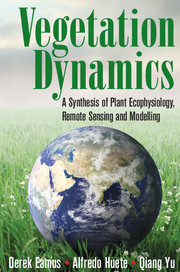Preface
Published online by Cambridge University Press: 05 June 2016
Summary
“Classical” plant physiology is the study of physiological processes of individual plants of a single species growing in pots in glasshouses, growth cabinets and controlled-environment chambers. Single-factor experiments are frequently used to manipulate one variable (e.g. water supply, temperature) in order to establish the response of individual processes (e.g. transpiration rate, phloem loading) or whole plants (e.g. growth rate) to that variable. It has been an immensely powerful science, contributing to increased food productivity and crop genetic selection for many decades.
Ecophysiology takes knowledge gained from plant physiological studies and applies them to plants growing “in the wild”, in real landscapes. This adds several layers of complexity arising from (a) large spatial and temporal variations in multiple variables (e.g. rainfall, temperature, solar radiation); (b) the interactions amongst multiple variables; and (c) complexities arising from the fact that landscapes are composed of multiple species. Although manipulative experiments can be undertaken in ecophysiology (e.g. rainfall exclusion, and rainfall redistribution troughs), the majority of ecophysiological studies do not manipulate environmental variables. Rather, they allow natural seasonal and inter-annual variation to impact on the structure and function of natural vegetation and measure the response of individual leaves, plants (trees, grasses, etc.) and canopies and use statistical inferences and models to analyse these responses.
Modelling of plant function can similarly be undertaken at small (leaves; xylem function), intermediate (trees, canopies) and large scales (stands, regions, sub-continental, global) across a range of temporal scales (typically hours to centuries). These models incorporate plant physiological and ecophysiological data (e.g. light response curves of leaves, eddy covariance tower flux data) to model the function (e.g. gross primary productivity [GPP], net primary productivity [NPP], evapotranspiration [ET]) of landscapes and biomes.
Remote sensing (RS) uses air-borne and satellite platforms for remote surveillance of land and vegetation surfaces (e.g. reflectance of solar radiation across multiple wavebands, land surface temperature). Using these remotely sensed data, plant structural attributes (e.g. LAI) and functional attributes (e.g. NPP, ET) can be calculated. As is the case for modelling, RS as a discipline is increasingly using physiological and ecophysiological (e.g. canopy conductance, canopy gas fluxes, LAI) data to validate/test/compare remotely sensed estimates of landscape processes and vegetation structure. Figure I.1 provides a simplified representation of these three disciplines and their overlap.
- Type
- Chapter
- Information
- Vegetation DynamicsA Synthesis of Plant Ecophysiology, Remote Sensing and Modelling, pp. xi - xivPublisher: Cambridge University PressPrint publication year: 2016

